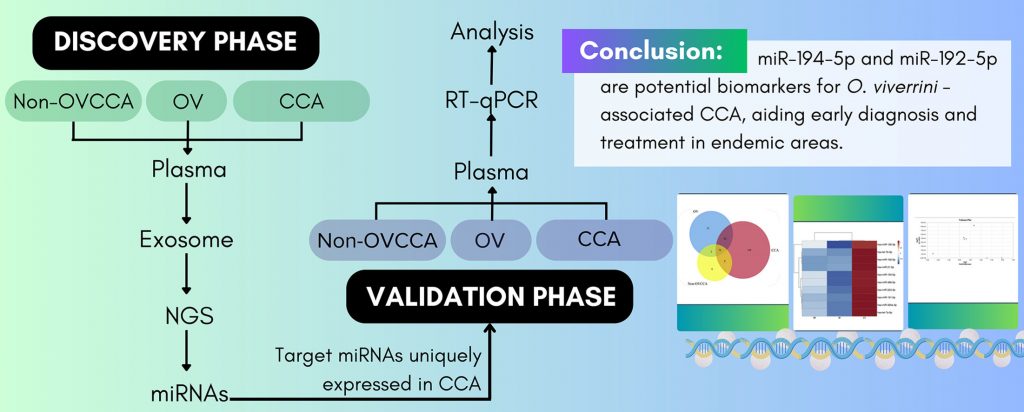
Highlight
การวิเคราะห์โปรไฟล์ไมโครอาร์เอ็นเอ (miRNA) ในเลือดของผู้ป่วยมะเร็งท่อน้ำดี (CCA) ผู้ติดเชื้อพยาธิ Opisthorchis viverrini และคนสุขภาพดี โดยใช้เทคโนโลยี NGS พบว่า miR-194–5p และ miR-192–5p มีศักยภาพเป็นตัวบ่งชี้ทางชีวภาพในการตรวจหา CCA และการติดเชื้อ O. viverrini ในระยะแรก ซึ่งจะช่วยให้การรักษามีประสิทธิภาพยิ่งขึ้นและเพิ่มโอกาสในการรอดชีวิตของผู้ป่วย
ที่มาและความสำคัญ
มะเร็งท่อน้ำดี (Cholangiocarcinoma: CCA) เป็นโรคมะเร็งที่มีความรุนแรงสูงและพบได้บ่อยในภูมิภาคเอเชียตะวันออกเฉียงใต้ โดยเฉพาะจากการติดเชื้อพยาธิใบไม้ตับ Opisthorchis viverrini การติดเชื้อนี้มักไม่แสดงอาการ ทำให้ผู้ป่วยจำนวนมากได้รับการวินิจฉัยเมื่อโรคอยู่ในระยะลุกลาม ส่งผลให้มีทางเลือกในการรักษาน้อยลงและโอกาสรอดชีวิตน้อย ไมโครอาร์เอ็นเอ (miRNAs) ได้รับการยอมรับว่าเป็นตัวบ่งชี้ชีวภาพที่มีศักยภาพสำหรับการตรวจหามะเร็งในระยะแรก แต่การนำมาใช้สำหรับวินิจฉัย CCA ยังมีข้อจำกัดอยู่มาก การศึกษานี้มีเป้าหมายเพื่อวิเคราะห์โปรไฟล์ของ miRNAs ในเอ็กโซโซม ซึ่งเป็นถุงขนาดเล็กในเลือดใน ผู้ป่วย CCA ที่ติดเชื้อ O. viverrini และคนสุขภาพดี เพื่อพัฒนาเป็นตัวบ่งชี้ทางชีวภาพที่เชื่อถือได้สำหรับการตรวจวินิจฉัยในระยะเริ่มต้น ซึ่งจะเพิ่มโอกาสรอดชีวิตของผู้ป่วยได้มากขึ้น
Abstract
Cholangiocarcinoma (CCA) is a life-threatening disease that impacts patients worldwide. In Southeast Asian countries, the liver fluke Opisthorchis viverrini plays a major role in inducing carcinogenesis of the bile ducts. Due to its asymptomatic nature, O. viverrini infections are rarely treated, consequently leading to the development of advanced stages of CCA before diagnosis. Despite the current use of exosomal microRNAs (miRNA) as diagnostic biomarkers for the early detection of many types of cancer, the applications for miRNA remain limited with CCA. Circulating exosomes, membranous vesicles essential for intercellular communication, were found to contain unique miRNA. In this study, we conducted next-generation sequencing (Ion Torrent PGM) and bioinformatics to characterize and compare the contents of exosomal miRNA derived from the plasma of CCA patients, O. viverrini-infected patients, and healthy individuals, as well as to identify and validate key molecules as markers for screening the diagnosis of CCA and O. viverrini infection. The obtained results showed the success of using NGS technology in discovering exosomal miRNAs, specifically miR-194–5p and miR-192–5p, both of which were upregulated in the O. viverrini-infected group. Interestingly, miR-192–5p was upregulated while miR-194–5p was downregulated in CCA, suggesting their potential use as biomarkers for screening CCA and O. viverrini infection, especially in O. viverrini-endemic areas.
KEYWORDS: Opisthorchis viverrini, Cholangiocarcinoma, miRNA, Exosome, Biomarker
Citation: Supradit, K., Wongprasert, K., Tangphatsornruang, S., Yoocha, T., Sonthirod, C., Pootakham, W., Thitapakorn, V., Butthongkomvong, K., Phanaksri, T., Kunjantarachot, A., Klongprateeppon, H., Sattavacharavech, P., & Prasopdee, S. (2024). microRNA profiling of exosomes derived from plasma and their potential as biomarkers for Opisthorchis viverrini-associated cholangiocarcinoma. Acta tropica, 258, 107362.
https://doi.org/10.1016/j.actatropica.2024.107362
RELATED SDGs:
3. GOOD HEALTH AND WELL-BEING

ผู้ให้ข้อมูล: ศาสตราจารย์ ดร.กนกพรรณ วงศ์ประเสริฐ
ชื่ออาจารย์ที่ทำวิจัย: ศาสตราจารย์ ดร.กนกพรรณ วงศ์ประเสริฐ
Credit ภาพ: ศาสตราจารย์ ดร.กนกพรรณ วงศ์ประเสริฐ
Tags: Biomarker, Cholangiocarcinoma, Exosome, miRNA, Opisthorchis viverrini
